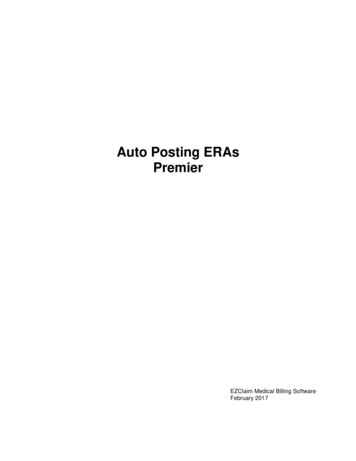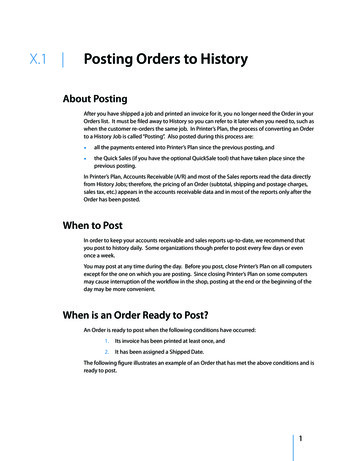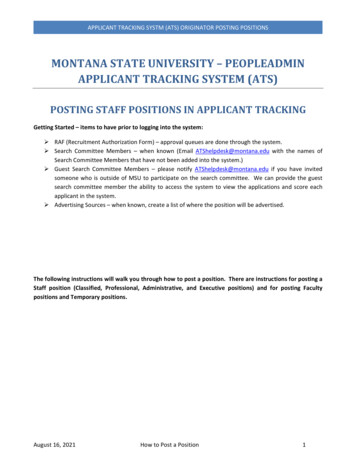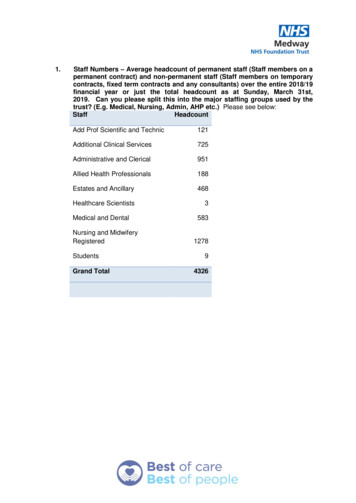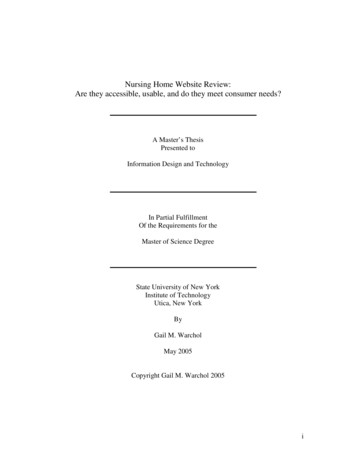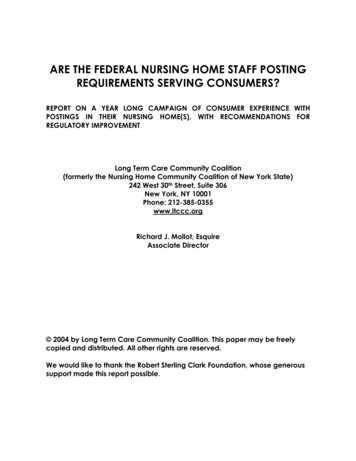
Transcription
ARE THE FEDERAL NURSING HOME STAFF POSTINGREQUIREMENTS SERVING CONSUMERS?REPORT ON A YEAR LONG CAMPAIGN OF CONSUMER EXPERIENCE WITHPOSTINGS IN THEIR NURSING HOME(S), WITH RECOMMENDATIONS FORREGULATORY IMPROVEMENTLong Term Care Community Coalition(formerly the Nursing Home Community Coalition of New York State)242 West 30th Street, Suite 306New York, NY 10001Phone: 212-385-0355www.ltccc.orgRichard J. Mollot, EsquireAssociate Director 2004 by Long Term Care Community Coalition. This paper may be freelycopied and distributed. All other rights are reserved.We would like to thank the Robert Sterling Clark Foundation, whose generoussupport made this report possible.
Table of ContentsExecutive Summary3Background of Requirement4Benefit of Requirement4Impetus for Present Study5Key Findings & Recommendations6Preliminary CMS Guidelines10Further Recommendations11Appendix (Posting Form)13Long Term Care Community Coalition2
Executive SummaryDirect care staffing levels are widely recognized as one of the most importantindicators of quality of care in nursing homes. Numerous studies havedemonstrated a strong, direct correlation between staffing levels and residentsafety and well-being. Many states have recognized this by requiring minimumratios of staff to residents to safeguard residents.In 2001, the Centers for Medicare and Medicaid Services (CMS) of the U.S.Department of Health and Human Services announced its “Nursing Home QualityInitiative.” The stated goals of this initiative include “continuing regulatory andenforcement systems and new and improved consumer information andcollaborative efforts to promote quality awareness and improvement. ”1 As partof this initiative CMS mandated that as of January 1, 2003 every nursing home inthe country must post in a prominent, public place the numbers of licensed andunlicensed direct care staff on duty for every shift. We were pleased to see CMSundertake these initiatives to improve quality and to inform consumers aboutthese critical indicia.From February 2003 through February 2004 the Long Term Care CommunityCoalition conducted a campaign asking people to report on the postings innursing homes in their community. Our objective was to gain insights into reallife experiences with the postings: were facilities complying?, were the postingseasy for people to find?, were they understandable?, were they perceived to beaccurate?, etc .2 This campaign focused on New York State. However, itgained national attention, thanks to the National Citizens Coalition for NursingHome Reform publicizing the campaign in its newsletter. As a result, we receivedfeedback from individuals across the country, though the large majority werefrom New York State.Our results indicate that though the federal requirement appears to be widelycomplied with, numerous strengths and weaknesses became apparent in howfacilities were complying. For example, many facilities posted information bytheir reception area or entry, but many others put the posting in a variety of otherareas, some far from the public view (in opposition to the CMS guidelines).Similarly, though the initial guidelines recommend that the postings be 8.5” x 14”or greater, the vast majority of reports we received did not comply, withapproximately 8.5” x 11” being the most popular choice, but the sizes rangedwidely – from 2” x 3” to 15” x 15”.Overall, our findings clearly indicate that the postings must be easy to find, easyto read, accurate and consistent in order for them to be valuable. They mustalso give people sufficient information to easily calculate a facility’s staffing levelsand be able to compare them to other facilities. In order for these goals to be42 CFR Part 483 [Federal Register: February 27, 2004 (Volume 69, Number 39), pages 92829288].2 See Appendix for a copy of the form used to collect the information.1Long Term Care Community Coalition3
accomplished, the final regulations must clearly state the parameters for thepostings as well as strong oversight mechanisms and fines for non-compliance.Background of RequirementSince January 1, 2003, Section 941 of the Medicare, Medicaid, and SCHIPBenefits Improvement and Protection Act of 2000 (BIPA) requires that nursinghomes post daily, for each shift, the number of licensed and unlicensed nursingstaff directly responsible for resident care in the facility. According to theCenters for Medicare & Medicaid Services (CMS), “[t]he required facility nursingstaff numbers must be prominently displayed in a public area. CMS suggests thesize of the report be at least 8 ½ x 14 inches, and printed in a size font/print largeenough to be easily read. This information must include the actual number oflicensed and unlicensed nursing staff directly responsible for the care of residentsfor that particular day on each shift. This may mean that the nursing facility wouldpost each shift staff numbers very close to the beginning of the shift in order toensure that the posted numbers are the actual staff working the shift. Licensedand unlicensed nursing staff includes: registered nurses (RNs), licensed practicalnurses (LPNs), and nurse aides.”3 According to the same directive, State SurveyAgencies are charged with verifying that nursing staffing information is posted forall surveys performed on or after January 1, 2003.Benefits of RequirementDirect care staff – RNs, LPNs and CNAs (certified nurse aides) – are truly the lifelinefor nursing home residents. Numerous studies have shown that there is a strong,direct correlation between staffing levels and resident safety and well-being.4Unfortunately, understaffing is a widespread and serious problem throughoutNew York and the entire country. According to recent federal reports, greater“than 90 percent of the nation’s nursing homes have too few workers to takeRequired Posting of Nursing Staff Numbers, Centers for Medicare & Medicaid Services, 2002,available at http://www.cms.hhs.gov/medicaid/bipa/bipanh.asp?. See, also, “DearAdministrator” letter from then Administrator Thomas Scully, available , which repeats much of the samelanguage and includes a “recommended template” for facilities to use.4 See U.S. General Accounting Office, Nursing Homes: Quality of Care More Related toStaffing than Spending, GAO-02-431R (Washington, D.C.: June 13, 2002); Centers forMedicare & Medicaid Services, Report to Congress: Appropriateness of Minimum NurseStaffing Ratios in Nursing Homes, Phase II Final Report (Baltimore, Md.: December2001); U.S. Department of Health and Human Services, Quality of Care in Nursing Homes:An Overview, Office of Inspector General (Washington, D.C.: March 1999); and Institute ofMedicine, Nursing Staff in Hospitals and Nursing Homes: Is it Adequate? (Washington,D.C.: National Academy Press, 1996).3Long Term Care Community Coalition4
proper care of patients”5 and approximately 98 percent of New York’s nursinghomes lack sufficient staff to provide adequate care.6As a result of this crisis in staffing there is a crisis in care: residents in facilities withlow staffing are much more likely to experience malnourishment, dehydration,bedsores and other serious – often life threatening – health problems. Thus, thepotential benefits of requiring that every facility post its staffing levels areenormous. If done well they give consumers – nursing home residents andpotential residents as well as their families and friends – timely and accurateinformation on the current staffing levels in an individual nursing home.Having reliable, accessible information on a nursing home’s staffing levels is oftremendous benefit to consumers for a number of reasons: It gives key insight into the level of care a facility is providing It enables consumers to easily compare staffing levels in different homes It gives potential residents the chance to “walk away” before beingadmitted to a facility if they don’t like what they see It allows consumers and their families to know how a facility benchmarksagainst known staffing level standards It enables consumers and advocates to have access to key informationthat they can use for advocacy with the government, in the media andwith the providers themselves It gives long term care ombudsman and government surveyors a keypiece of information relating to a facility’s ability to provide adequatecare and a safe environment By its very existence – publicizing staffing levels – the posting has thepotential of compelling providers to improve staffing ratios in their facilities.Impetus for Present StudyAs noted above, there are numerous ways in which the staff posting requirementcould be extremely helpful for improving care to nursing home residents on bothindividual and systemic bases. However, in order for it to be useful, theinformation must not only be accurate and up to date, it must also be easilyaccessible and understandable. In addition, the information must becomprehensive and complete – enabling the reader to easily make accuratedeterminations about the level of care in any given facility, with the ability toeasily compare levels between facilities and against state, national and otherdata.To gain insight into these issues, the Long Term Care Community Coalition(formerly the Nursing Home Community Coalition) conducted a campaign fromSee Robert Pear, Nursing Homes in U.S. Lack Adequate Staff, a Government Study Finds, TheNew York Times, February 18, 2002, (reporting on findings of 2002 Healthcare FinancingAdministration (now CMS) report on nursing home staffing).6 HCFA (now CMS), Appropriateness of Minimum Nursing Staff Ratios in Nursing Homes, Reportto Congress, July 2000.5Long Term Care Community Coalition5
the beginning of 2003 to the beginning of 2004 asking people who go to nursinghomes to report to us on the staff posting. Our key goal was to gain insight intohow people were perceiving the posting: was it useful. In order to find out, wedeveloped a one page form for people to fill out which asked for the followinginformation: name, address, county and zip code and then ten short answerquestions: date and time posting was checked, was there a posting?, was it easyto find?, easy to read?, how large?, where posted?, what were numbersposted?, did the respondent feel the numbers were accurate?, if they know howmany residents were in facility and if yes the number, and (added in the middleof campaign) whether person reporting was a resident, family/friend, staff,ombudsman, other? The form also had a space where the respondent could, attheir option, list personal information.The form was publicized and distributed through our newsletters and website. Inaddition, many of our members (which exist of both organizations andindividuals) printed out and distributed copies, a press release calling forcontributions was sent to newspapers throughout New York state and theNational Citizens Coalition For Nursing Home Reform publicized the campaign,resulting in our receiving reports from people across the country.Following is a presentation of our findings.Key Findings & RecommendationsOverall, we received 309 responses that were usable, meaning that theycontained sufficient information, responded appropriately to the questions askedand were legible enough for us to read. Of these responses, at least 42 camefrom outside of New York (several responses listed incomplete location data),with Rhode Island, Puerto Rico, Louisiana, Washington, California, Nevada,Missouri and Montana all represented. Sixty eight people responded with reportsfor the evening shift, 182 for the day shift and 53 for the night shift, with 6respondents not giving a reporting time.Was there a posting?Yes: 284 (approximately 98%)No: 6 (approximately 2%)N/A: 19 Significance:Approximately 98% of the respondents found or noticed the posting. For 2% ofthe respondents either the nursing home was not in compliance with the lawor had not posted in a conspicuous place.Long Term Care Community Coalition6
Recommendation:While 98% is a very high compliance finding, given that anyone who took thetime to take part in the campaign was likely to be more actively seeking outthe posting than the general public, we had hoped it would be 100%. Severalpeople noted that that they found the posting in an out of the way place or aplace where the public does not generally go, a further indication that for thegeneral public this number would likely be lower than that reported here.See our recommendations below related to site and size of posting.What was size of posting?We received a surprisingly wide range of responses to this question, from 2” x3” to 15” x 15”. 176 people reported that the posting in their facility wasapproximately 8.5” x 11”, representing approximately 57% of all respondents.Forty people (approximately 13%) reported that the posting in their facility wasapproximately 8” x 14” and 30 (approximately 10%) reported posting ofapproximately 5” x 8”. Significance:These three reported posting sizes, represented 246 (almost 80%) of therespondents. Another 20% of respondents reported a wider range of diversesizes and shapes. Recommendation:Because size is a critical factor in the value of the staff posting information –people need to be able to readily find the posting and easily read theinformation it contains – CMS must require a minimum size. Especially giventhat the population of nursing home residents and visitors is older than theaverage population, bigger is better. We also recommend consistency in thesize of the required form, to make identification easier for people and alsorecommend that the required size be a standard for which paper is readilyavailable, to facility compliance with the regulation. Given all of theseconsiderations, we recommend that CMS require that the posting be 11” x14”, “legal size” paper which is readily available and can be used in mostoffice equipment. Under no circumstances should it be permitted for theposting to be less than 8.5” x 11” (a standard sheet).Where was sheet posted?Similar to the size question, we received a great variety of responses to thisquestion. The findings:115 people (approximately 39%): the lobby/entry/reception area,57 (approximately 19%) on a community bulletin board,Long Term Care Community Coalition7
48 (approximately 16%) by an elevator,31 (10%) by a nurses’ station,24 (approximately 8%) by a director of nursing or other administrative office,17 (approximately 6%) were in a place where the public generally didn’t go(such as by an employee time clock), and4 (approximately 1%) found the postings on residence floors.22 did not answer the question and 9 gave information that was not usable.It is important to note that several people reported on multiple postings in agiven facility, which is why the total number above is more than 309. Oneperson reported, remarkably, that their facility was not posting the data, butinstead handing it out as an enclosure in a packet given to residents. Significance:Like the size of the posting, this is also a very significant issue: people should beable to easily locate the posting in a facility. Otherwise, the entire enterprise isof little use. It was unfortunate to see such diverse responses, since it would bemost beneficial for people to have a single established place to find thepostings. Recommendation:CMS should amend its regulations to require consistency in placement ofposting among all facilities by mandating a specific place in the facility wherethe information should be posted. One person we talked to said that theposting should be “as easy to find as the front door.” Needless to say, thisshould be a prominent place to which residents and visitors have easy access,and where they would expect to find notices and other information. TheCoalition strongly recommends that CMS require the posting to be in thereception area or entry, the place where visitors routinely gather. If possible,it would be preferable for facilities to post in a prominent within the facilitytoo, in a place where residents frequent, such a community bulletin board.Do you believe that the numbers posted are accurate?The findings indicate that only 78% of the respondents felt the numbers wereaccurate.Yes: 190 people (approximately 78%),No: 33 (approximately 14%),Not sure: 20 (approximately 8%),N/A: 66.Long Term Care Community Coalition8
Significance:Since this study focused on impressions and did not authenticate thenumbers, we are limited in the extent to which we can judge whether theanswers to this question accurately reflect conditions in the nursing homes.However, since a large number of the people who reported to us wereombudsman7 and therefore had a greater ability than the average person tosee what is going on in a facility and get a sense of actual staffing levels orwere citizen advocates or family advocates who would have a good abilityto make judgments on this issue, believe their perceptions are accurate. Thus,it is meaningful that only 78% of those answering this question felt that theposting was accurate. It indicates two possibilities: that some of the facilitiesare not being honest about their staffing levels (which coincides with thewidely held belief that many facilities inflate their staffing figures for reportingpurposes and at survey times) and/or that those who reported that theposting was not accurate had little faith in the quality and/or integrity of theirfacility. Neither possibility reflects well on the nursing home industry. Recommendation:CMS must promulgate a strong enforcement mechanism to ensure thatposting data is accurate and meets other requirements of the final regulation.Otherwise, there is a great risk that the entire enterprise will be meaningless.Possible enforcement mechanisms include a significant fine structure, a strongoversight role for the states and ombudsman (which could be funded by finescollected), a toll-free number and easy to use website for consumers to voicecomplaints or concerns about violations, establishment of a procedure forverification of posting information by employee records or payroll records(either on a regular basis or spot checking).Was posting easy to find and easy to read?Easy to Find:Yes: 272 (approximately 95%)No: 15 (approximately 5%)N/A: 22We changed our posting form early in the year in which we collected data to include aquestion asking the reporter to identify whether they were friend/family, resident, staff,ombudsman, etc Unfortunately, due to the fact that many people continued to usecopies of the original form, and that we had already collected significant data beforechanging the form, we do not have enough information to accurately report and assess themake-up of people who participated in the campaign. However, because we received alarge number of forms from Ombudsman offices, and that the National Coalition for NursingHome Reform, which is host to the National Long Term Care Ombudsman Resource Center,had a big role in publicizing this campaign and disseminating the posting forms, we believethat ombudsman represented a large number of respondents.7Long Term Care Community Coalition9
Easy to Read?Yes: 257 (approximately 97%)No: 8 (approximately 3%)N/A: 38 Significance:We were glad to see that approximately 95% of respondents felt that theposting was easy to find and 97% found it easy to read, particularly given thelack of guidelines from CMS. However, again, these findings must beinterpreted in light of the fact that all respondents set out to find the postingand were, minimally, more aware of the posting and what it was supposed tobe reporting than the average person. Recommendation:CMS should standardize the chart with a model that has been pilot tested toensure maximum comprehension and minimal confusion among its potentialaudience. It is further recommended that the daily posting be posted with anexplanation of what the posting means, how to use them to determinestaffing levels (ratios), the significance of the information and contacts forwhere to go with questions, concerns or complaints.Preliminary GuidelinesOn February 27, 2004 the Centers for Medicare and Medicaid Services issuesproposed rules for the nursing home staff posting. Following are the keyprovisions: Posting must “[c]ontain current nurse staffing numbers (FTEs) [full timeequivalents] for each shift” It is expected that the “form would be completed at the end of each shiftwith a total FTE count of nursing staff who were actually present andproviding direct care to residents.” It is expected “that the actual completion of the FTE count would notcommence until after the staff for that shift had actually worked.” Posting must “[c]ontain the daily resident census” Posting must be “posted on the CMS Daily Nurse Staffing Form”8 “[P]roposed regulation would not require data collection on other staff,volunteers, or feeding assistants” Posting must “[b]e displayed in a prominent place readily accessible toresidents and visitors”Proposed standard posting form, 9287 Federal Register, Vol. 69, No. 39, p. 9287. The form is astandard 8 ½ x 11” sheet of paper. To view or download from the Internet, go .8Long Term Care Community Coalition10
Facilities would be required to make collected information available to thepublic and to “retain the Daily Nurse Staffing Form for a minimum of 3years, or as required by State law, whichever is greater”Facilities would not be required to report information to CMS or stateagencies “at this time”Further RecommendationsIn addition to our recommendations stemming directly from the results of thereporting campaign (presented above in bold with each key finding), we havegeneral comments and recommendations regarding the preliminary guidelinesissued by the CMS in February. These recommendations are based on thehundreds of reports we received of individual citizens’ real life experiences withthe posting forms as well as our own extensive experience in advocacy andresearch on nursing home care, oversight and regulation: The posting must include data on the present shift of direct care workers. Inorder for this information to be of value, people must be able to have theability to verify the information posted. This would be impossible if thepresent shift is not posted. Information should be posted within an hour ofthe beginning of the shift. In addition, we strongly recommend that theprevious day’s postings for all three shifts be required to be posted as well,so that people can readily see important information about a facility’s mostrecent staffing patterns. A resident census must be included in the posting. This is also a criticalfeature that is necessary for the posting to be of value. It is not helpful toknow how many workers are in the facility if one does not know how manypeople they have to care for. We are glad to see this in the preliminaryguidelines from CMS and strongly support their inclusion in the finalregulation. Posting should use standardized size and format that offers maximum clarityfor consumers. We support the development of a standard posting form, asstated in the proposed guidelines, but believe that the size should bestandardized too, to legal size paper (11” x 14”) which is easily availableand suitable for standard office equipment (therefore not overlyburdensome for providers) yet it will provide a large size to facilitate viewingease. If other personnel besides licensed nurses and CNAs – such as so-calledfeeding assistants –are allowed to provide direct care to residents, theyshould be required to be listed on the form separately. Many consumers,consumer advocates and experts are concerned by the Department ofHeath and Human Services recent decision to allow feeding assistants witha fraction of the training required of CNAs to provide vital services tovulnerable nursing home residents with little supervision. We believe that ifthe states and federal government allow nursing homes to set up a new tierLong Term Care Community Coalition11
of direct care workers these people must be listed in the posting separately.This is an important piece of information integral to any determination ofcare levels (whether one is in favor of feeding assistants or opposed tothem). The facilities should be required to keep the information collected andmake it available to the public for at least three years. We strongly supportthis aspect of the proposed guidelines. Facilities should be required to submit all posting information to CMS, or atleast, a protocol should be established for submission to the individual statesand for the establishment of state databases. We were disappointed to seeCMS take the opposite viewpoint in the proposed regulations; this could bea very valuable way for them to track this important information.Long Term Care Community Coalition12
HELPTHE NURSING HOMECOMMUNITY COALITIONKEEP TABS ON STAFFING INNURSING HOMESAs of January 1, 2003, nursing homes are required to post "in aclearly visible place" the number of nursing staff on duty for eachshift. Those who must be included are the Registered Nurses (RNs),Licensed Practical Nurses (LPNs) and Nurse Aides directlyresponsible for resident care. Some nursing homes might show RNsand LPNs together as “licensed nurses.”Families, friends, residents and staff from all over the state will becontributing to this important effort. Please take a few moments toanswer the following questions for the nursing home you live in orvisit.NHCC will use your answers to make sure that nursing homes arecomplying with the law and that the information is posted in a waythat is helpful to consumers. It will also help us determine whetherwe need to advocate for improvements to the law in the future.This is important information that can help you and otherconsumers determine the kind of care a facility is providing.We encourage you to make and distribute copies of this form sothat we can get as much information as possible. Feel free to fillout a form every time you visit – every report we receive will helpus determine if this new law is working to benefit residents. Even ifyou have found that there was no posting, it is extremely importantthat we hear from you.Thank you.Long Term Care Community Coalition13
HELP THE NURSING HOME COMMUNITY COALITION KEEP TABS ON STAFFING IN NURSINGHOMESNURSING HOME POSTING OF STAFF ON DUTY - REPORTING FORM- Please Print Name of Nursing Home:Address & County of Nursing Home:1. Date and time of day posting was checked: Day Eve Night2. Does the Nursing Home have a posting? Yes No3. Is it easy to find? Yes No4. Is it easy to read? Yes No5. How large is it (approximately)?6. Where was it posted (check all that apply)? Near the entry or reception desk On or near a community bulletin board On residence floors Near nurse station(s) Somewhere else (please tell uswhere)7. What were the numbers posted? RNs LPNs Nurse Aides(NOTE: If numbers are only given for “Licensed” and “Unlicensed” Nursing Staff,please fill in under LPNs and Nurse Aides, respectively, and check here )8. Do you feel that this number accurately reflected the number of direct care staffon duty? Yes No Why?9. If you know how many residents are in the facility, write number:10. Are you Family Member/Friend Resident Staff Ombudsman OtherOptional Information (all personal information will be kept confidential):Your Name:Contact Information:Email Address: Check to join our Action Alert List: Comments:RETURN THIS PAGE TO NHCC Posting, 11 John Street, Suite 601, New York, NY 10038 or fax212-732-6945. PLEASE DO NOT ATTACH ANY ADDITIONAL FORMS OR INFORMATION.Thank You.Long Term Care Community Coalition14
5 See Robert Pear, Nursing Homes in U.S. Lack Adequate Staff, a Government Study Finds, The New York Times, February 18, 2002, (reporting on findings of 2002 Healthcare Financing Administration (now CMS) report on nursing home staffing). 6 HCFA (now CMS), Appropriateness of Minimum Nursing Staff Ratios in Nursing Homes, Report to Congress, July .
